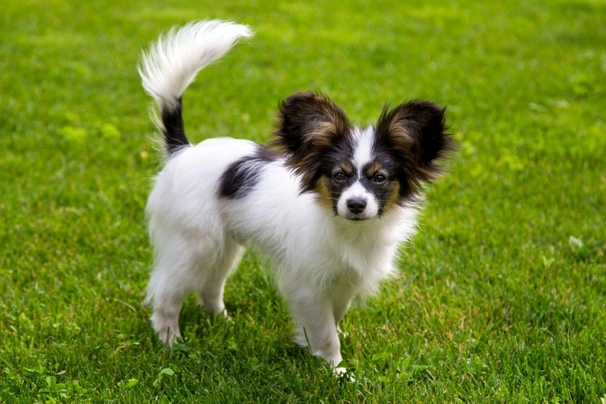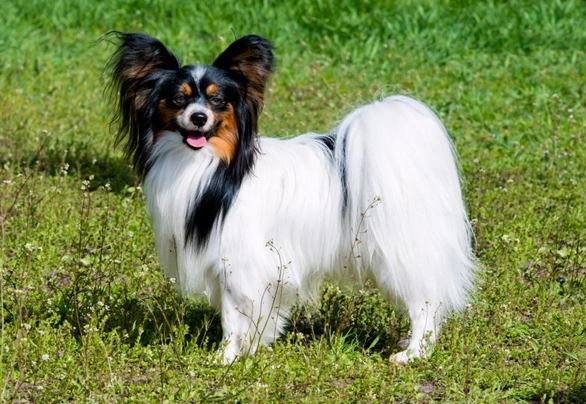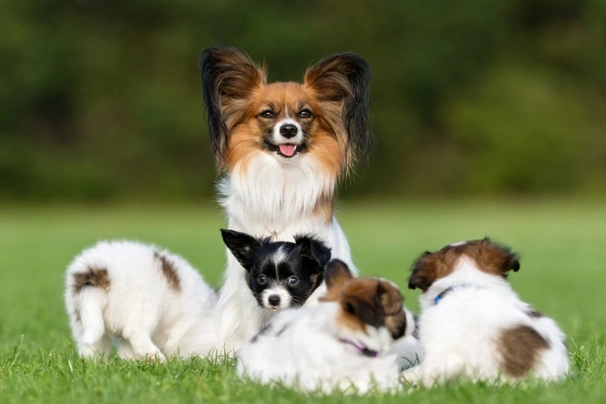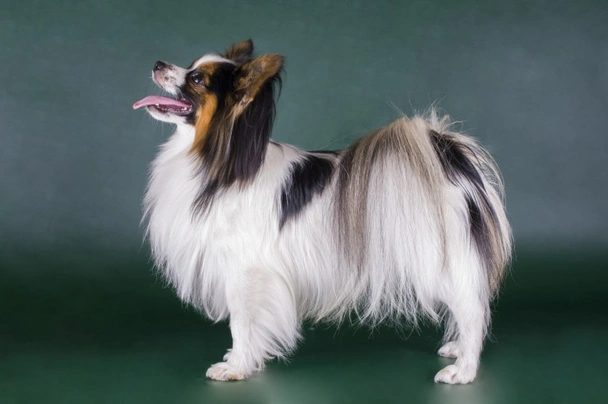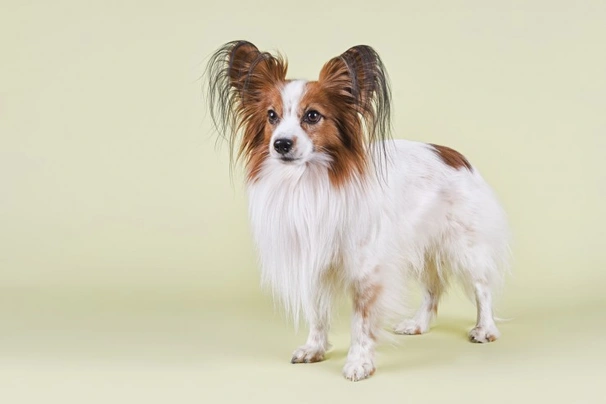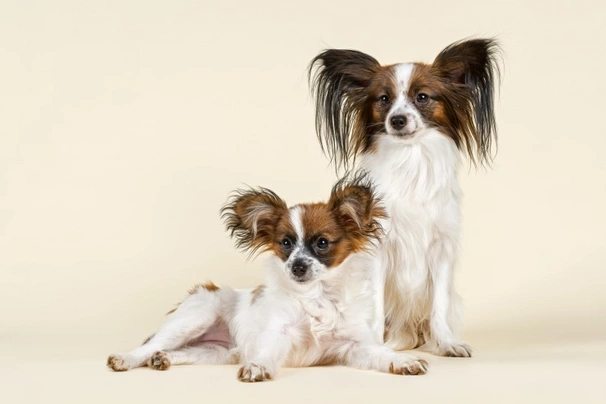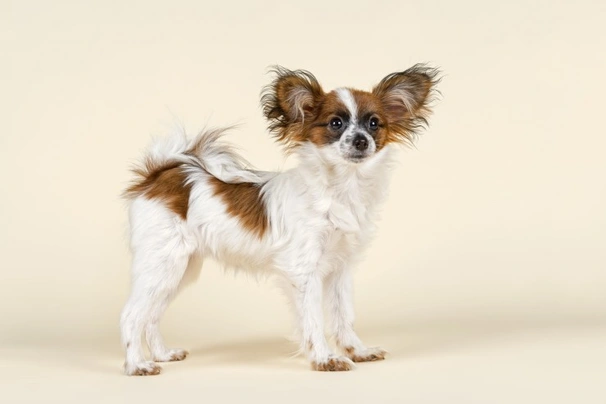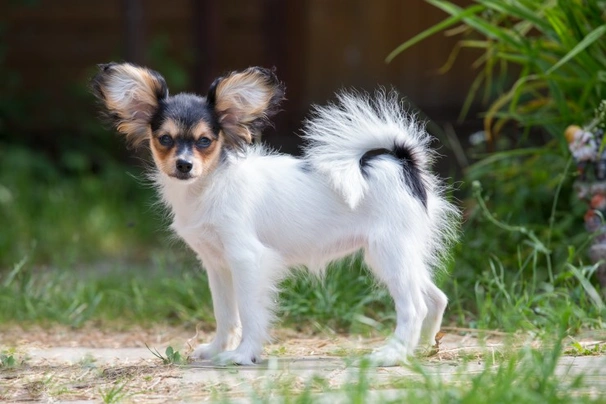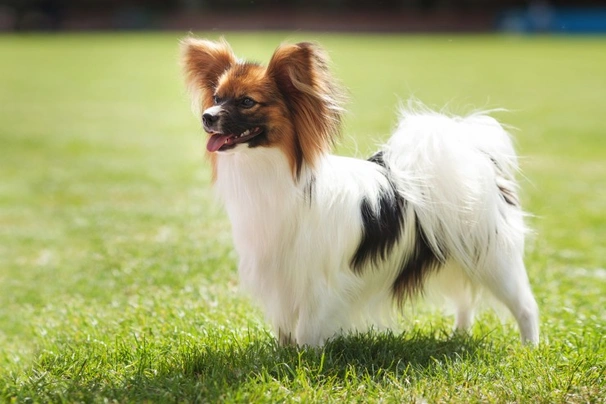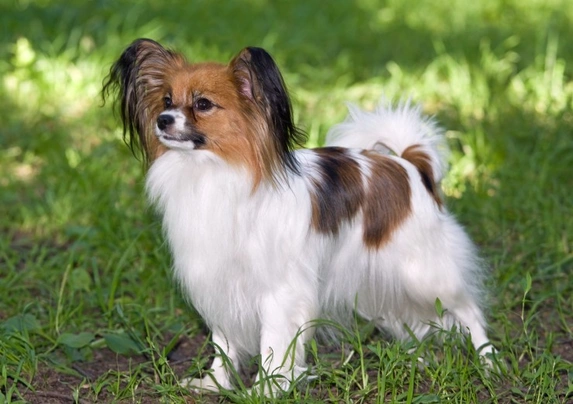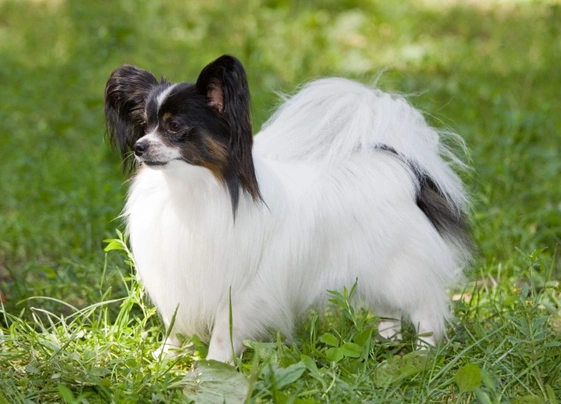Papillon
Pros
Cons
Introduction of the Papillon
Papillons are popular little dogs with a very spaniel type look about them and they are often referred to as being "continental toy spaniels". Over time have found their way into the hearts and homes of many people both here in the UK and elsewhere in the world and for good reason. Not only is the Papillon adorable looking but they rank number 8 out of 79 other breeds when it comes to intelligence.
Interestingly both France and Belgium claim these little dogs as being native to their countries and indeed both are listed as being the breed’s home whether it’s the drop-eared dog known as the Phalene or the Papillon with their upright ears. The breed's name "Papillon" translated from French means butterfly which describes well their delicate appearance and lovely feathering around a dog's ears whereas “Phalene” is French for moth.
History of the Papillon
There are records of the Papillon that date back 700 years but the exact origins and where the breed first appeared remains a bit of mystery with both France and Belgium claiming that the breed belongs to them. There are some breed enthusiasts who believe that the Papillon may be a descendant of toy breeds from Asia namely the Japanese Chin but other people think they are smaller versions of spaniels found in Europe and that the Papillon was created by breeding small specimens of spaniels without having to introduce any other breed from Asia or the Far East into the mix. What is known is that their origins belong to the European Toy Spaniel and that during the 16th century these little dogs were a firm favourite with royals and the nobility alike.
Dwarf Spaniels with long folded ears were around during Louis the Great's reign and they were known as "Phalene" which as previously mentioned is French for "moth". As time passed some puppies were born with erect ears that were set further down on a dog's head and which were nicely feathered with silky long hair. It is not known why these puppies had different ears but there are some people who think that the Phalene was crossed with miniature spitz-type dogs with "pricked ears" and this led to some puppies being born with feathered erect ears.
It is worth noting that even today puppies from the same litter can have either type ears whether they are drop or erect. Another interesting fact about the breed is in their colouring which again was further developed over time. Originally Dwarf Spaniels had solid coloured coats whereas the modern day Papillon typically has a predominantly white coat with patches of colour in it.
Although small in stature and delicate in appearance the Papillon has always been highly prized for being an excellent ratter as well as tracking dog. Today they do extremely well when competing in all sorts of canine sports which includes agility and obedience. The Papillon is also a popular breed in the showring thanks to their adorable looks.
Throughout time the breed has been hugely popular throughout Europe but the Papillon was only introduced to the UK in 1901 and was not recognised by the Kennel Club until 1923. From then onwards these little dogs found their way into the hearts and homes of people both here in the UK and elsewhere in the world including the States thanks to their charming looks their intelligence and their affectionate loyal natures. The breed was recognised by the American Kennel Club in 1935.
Interesting facts about the breed
- Is the Papillon a vulnerable breed? No they have consistently remained one of the more popular toy breeds in the UK and elsewhere in the world ranking 95 out of 238 other breeds on the Pets4homes website
- The name Papillon means "Butterfly" in French and the name "Phalene" means Moth in French
- They are thought to be descendants of "Dwarf Spaniels" that were around centuries ago
- Some people think the Papillon could be related to the Japanese Chin
- They were hugely popular with the nobility throughout Europe throughout the centuries
Appearance of the Papillon
Height at the withers: Males 20 - 28 cm Females 20 - 28 cm
Average weight: Males 3.6 - 4.5 kg Females 3.2 - 4.1 kg
The Papillon is a dainty little dog that seems to always have an intelligent and alert look about them. They have slightly rounded heads between their ears and their muzzles are neatly pointed being a lot more refined than their skulls. They have very well-defined stops and nice black noses that contrast beautifully with their coat colours. Eyes are medium in size and nicely rounded being dark in colour with dark rims.
Their ears are large and very mobile being rounded at the tips and heavily fringed. They are set towards the back of a dog's head yet wide enough apart so as not to hide a dog's slightly rounded head. The leathers are fine yet nicely firm to the touch. The Papillon has a strong jaw with a perfect scissor bite where their upper teeth neatly overlap their lower ones with their lips being thin tight and dark in colour.
Their necks are moderately long with dogs having well developed sloping shoulders. Chests are deep and front legs nice and straight delicate yet boasting strong fine bone. Their bodies are quite long with a nice level topline and well sprung ribs. Loins are strong and long with dogs having slightly arched bellies. Their hindquarters are well developed with neat strong back legs. Their feet are very hare-like being fine and quite long with long tufts of hair growing between a dog's toes. Their tails are long and well feathered being set high and which dogs carry arched over their backs so the fringes fall to one side which forms a plume.
When it comes to their coat the Papillon boasts an abundant single coat that's long fine and very silky to the touch. Their coat lies flat on a dog's back and on their sides but it forms a profuse frill on the chest. The hair is short and close on a dog's head muzzle and on the front parts of their legs. The backs of their front legs on their tails and thighs are covered with much longer hair. The accepted breed colours for Kennel Club registration are as follows:
- Black & White
- Dark Red & White
- Dark Red Sable & White
- Dark Sable & White
- Dark Shaded Sable & White
- Lemon & White
- Lemon Sable & White
- Pale Red & White
- Pale Red Sable & White
- Red & White
- Red Sable & White
- Sable & White
- Silver & White
- Silver Sable & White
- Tricolour
Gait/movement
When a Papillon moves they do so with a light flowing gait and when seen from the front or from behind their legs and feet move parallel to each other. A dog's feet should neither turn in or out when they move and when seen from the side Papillons cover a lot of ground without showing any sign of a hackneyed action.
Faults
The Kennel Club frowns on any exaggerations or departures from the breed standard and would judge the faults on how much they affect a dog's overall health and wellbeing as well as their ability to perform.
Males should have both testicles fully descended into their scrotums and it is worth noting that a dog can be a little lighter or heavier as well as slightly taller or shorter than set out in the Kennel Club breed standard which is given as a guideline only.
Temperament of the Papillon
The Papillion may be small in stature but they are highly confident and outgoing characters. They are also extremely smart and therefore capable of twisting their owners around their little paws which they are very adept at doing. It cannot be stressed enough the importance of early socialisation for these little dogs to prevent any unwanted and often aggressive behaviours developing. If their socialisation is left until a dog is older Paps are known to show a more dominant side to their natures which can often mean they become wilful and unruly.
With this said the Papillon is an affectionate friendly albeit very alert little dog that's always prepared to let their owners know when there are any strangers about but rarely would a Pap show any sort of aggressive behaviour towards people they don't know preferring to just keep their distance and bark. These dogs thrive on being around people and love nothing more than to be involved in everything that goes on in a household.
Paps are a very good choice for first time owners because they are always so willing and eager to please. This paired to the fact they are among the most intelligent dogs on the planet makes them extremely easy to train. However they need to be trained with a firm yet gentle hand so they understand their place in the "pack" and who is alpha dog in a household for them to be truly well-rounded dogs around the home.
Are they a good choice for first time owners?
Papillons are a good choice for first time dog owners because they are so adaptable and amenable by nature. They thrive on human contact and love nothing more than to please and entertain the people they love. With this said they are not the best choice for families with very young children because of their small size.
What about prey drive?
The Papillon has always been highly prized for their "ratting" abilities and are therefore always quick to give chase to anything that moves. As such care should always be taken when they are around any animals and pets they don't already know. Care should also be taken as to where and when a Papillon can run off the lead.
What about playfulness?
Papillons are known to have a very playful side to their natures and enjoy being involved in all sorts of canine sports which includes mini agility and obedience. They are known to be a little mischievous when the mood takes them and being so clever a Papillion quickly learns what pleases their owners and will test the limits and boundaries to see how much they can get away with just for the fun of it.
What about adaptability?
Papillons are highly adaptable dogs and providing they are given enough daily physical exercise combined with as much mental stimulation to prevent boredom from setting in they are just as happy living in an apartment in town as they are living in a house in the country.
What about separation anxiety?
Papillons form strong ties with their families and dogs are never very happy when they find themselves left on their own for longer periods of time. They are better suited to people who either work from home or in households where one person stays at home when everyone else is out so they are never alone for any length of time which could see a dog suffering from separation anxiety. This can lead to them being destructive around the home and barking incessantly which is a dog's way of relieving any stress they are feeling and a way to keep themselves entertained.
What about excessive barking?
Some Papillons like the sound of their own voices a little too much which is something that needs to be gently nipped in the bud when a dog is still young being careful not to frighten them bearing in mind that these small dogs like many spaniels are sensitive by nature and can easily be upset when treated unfairly.
Do Papillons like water?
Most Papillons are not that keen on getting their feet wet and given their small size care should always be taken when walking them anywhere near more dangerous watercourses just in case a dog decides to leap in and then needs rescuing because they can't get out of the water on their own.
Are Papillons good watchdogs?
Papillons may be small in stature but they are remarkably good watchdogs because they are always so alert as to what goes on in their environment. With this said they are more likely to keep their distance and bark incessantly rather than show any sort of aggression towards people who approach their territory.
Intelligence / Trainability of the Papillon
The Papillon is a highly intelligent little dog and one that is always eager and willing to please their owners which makes them very easy to train. However the key to successfully training them is to always be consistent and to start their education as early as possible. This would involve introducing a Pap to as many new situations noises people animals and other dogs once they have been fully vaccinated as possible.
Puppies can be a bit of a challenge to housetrain but with perseverance and understanding they can be taught to do their "business" outside. Paps are known to be very good therapy dogs and some even excel at being Hearing Dogs for the Deaf whereas other Papillons are extremely good at agility and obedience.
Papillon puppies are extremely cute and it is all too easy to spoil them when they first arrive in the home. However owners should always start out as they mean to go on which means setting out rules and boundaries so that a Papillon puppy understands what is acceptable behaviour and what is not. Like many other small and toy breeds if they get away with too much they can develop something called "small dog syndrome" which sees dogs being wilful and unruly making them harder to live with. The first commands a Papillon puppy should be taught as early as possible are as follows:
- Come
- Sit
- Stay
- Quiet
- Leave it
- Down
- Bed
Children and other
The Papillon is not the best choice for people with young families thanks to their small stature and the fact these little dogs can be a little snappy if they feel threatened in any way. With this said any interaction between children and a Pap should always be well supervised by an adult to make sure things stay nice and calm.
Paps can also be a little snappy and aggressive around other dogs and care needs to be taken whenever they meet any other small animals and pets because they would think nothing of chasing them and this includes cats because they do have a high prey drive.
Health of the Papillon
The average life expectancy of a Papillon is between 13 and 15 years when properly cared for and fed an appropriate good quality diet to suit their ages.
Like so many other breeds the Papillon is known to suffer from a few hereditary health issues which are worth knowing about if you are planning share your home with one of these active and good-looking dogs although it is worth noting that the Papillon is thought of as a healthy and robust little dog. The conditions that seem to affect the breed the most include the following:
- Congenital deafness - BAER test available through the Animal Health Trust (AHT)
- Progressive retinal atrophy - stud dog should be eye tested
- Von Willebrand’s disease - DNA test available through breed clubs
- Patellar luxation - Test available through breed clubs
- Black hair folliculitis
- Cataracts
- Entropion
- Mitral valve disease
- Micropapilla
- Intervertebral disc disease
- Allergies
- Dental problems
- Seizures
- Broken bones
What about vaccinations?
Papillon puppies would have been given their initial vaccinations before being sold but it is up to their new owners to make sure they have their follow-up shots in a timely manner with the vaccination schedule for puppies being as follows:
- 10 -12 weeks old bearing in mind that a puppy would not have full protection straight away but would be fully protected 2 weeks after they have had their second vaccination
There has been a lot of discussion about the need for dogs to have boosters. As such it's best to talk to a vet before making a final decision on whether a dog should continue to have annual vaccinations which are known as boosters.
What about spaying and neutering?
A lot of vets these days recommend waiting until dogs are slightly older before spaying and neutering them which means they are more mature before undergoing the procedures. As such they advise neutering males and spaying females when they are between the ages of 6 to 9 months old and sometimes even when a dog is 12 months old.
Other vets recommend spaying and neutering dogs when they are 6 months old but never any earlier unless for medical reasons. With this said many breeds are different and it is always advisable to discuss things with a vet and then follow their advice on when a dog should be spayed or neutered.
What about obesity problems?
Some Papillons gain weight after they have been spayed or neutered and it's important to keep an eye on a dog's waistline just in case they do. If a dog starts to put on weight it's important to adjust their daily calorie intake and to up the amount of exercise they are given. Older dogs too are more prone to gaining weight and again it's essential they be fed and exercised accordingly because obesity can shorten a dog's life by several years. The reason being that it puts a lot of extra strain on a dog's internal organs including the heart which can prove fatal.
What about allergies?
Papillons are prone to suffering from allergies and it's important for a dog to see a vet sooner rather than later if one flares up. Allergies can be notoriously hard to clear up and finding the triggers can be challenging. With this said a vet would be able to make a dog with an allergy more comfortable while they try to find out the triggers which could include the following:
- Certain foods more especially dog food that contains higher levels of wheat and other cereal fillers
- Airborne pollens
- Dust mites
- Environment
- Flea and tick bites
- Chemicals found in everyday household cleaning products
Participating in health schemes
All responsible Papillon breeders would ensure that their stud dogs are tested for known hereditary and congenital health issues known to affect the breed by using the following schemes:
- Test for progressive retinal atrophy through the BVA/KC/ISDS eye scheme
- DNA test for Pap-PRA1
- DNA test for Von Willebrand’s disease
- Test for Patellar Luxation through Papillon breed clubs
- Congenital deafness - BAER test available through the Animal Health Trust (AHT)
What about breed specific breeding restrictions?
Breeders have the option to choose to register their dogs and puppies as "Phalene" with the Kennel Club which they can do online or by standard mail.
What about Assured Breeder Requirements?
The Kennel Club strongly recommends that all breeders use the following tests and schemes on their stud dogs:
- Eye testing
- Breed Club - slipping patella
- DNA test for Pap-PRA1
Caring for the Papillon
As with any other breed Papillon need to be groomed on a regular basis to make sure their coats and skin are kept in top condition. They also need to be given regular daily exercise to ensure they remain fit and healthy. On top of this dogs need to be fed good quality food that meets all their nutritional needs throughout their lives.
Caring for a Papillon puppy
Like all puppies Papillons are boisterous and full of life which means it's essential for homes and gardens to be puppy-proofed well in advance of their arrival. A responsible breeder would have well socialised their puppies which always leads to more outgoing confident and friendly dogs right from the word go. With this said any puppy is going to feel vulnerable when they leave their mother and littermates which must be considered. The longer a puppy can remain with their mother the better although it should never be for too long either.
It's best to pick a puppy up when people are going to be around for the first week or so which is the time needed for a puppy to settle in. Puppy-proofing the home and garden means putting away any tools and other implements that a boisterous puppy might injure themselves on. Electric wires and cables must be put out of their reach because puppies love chewing on things. Toxic plants should be removed from flowerbeds and the home too.
Puppies need to sleep a lot to grow and develop as they should which means setting up a quiet area that's not too out of the way means they can retreat to it when they want to nap and it's important not to disturb them when they are sleeping. It's also a good idea to keep "playtime" nice and calm inside the house and to have a more active "playtime" outside in the garden which means puppies quickly learn to be less boisterous when they are inside.
The documentation a breeder provides for a puppy must have all the details of their worming date and the product used as well as the information relating to their microchip. It is essential for puppies to be wormed again keeping to a schedule which is as follows:
- Puppies should be wormed at 6 months old
- They need to be wormed again when they are 8 months old
- Puppies should be wormed when they are 10 months old
- They need to be wormed when they are 12 months old
Things you'll need for your puppy
There are certain items that new owners need to already have in the home prior to bringing a new puppy home. It's often a good idea to restrict how much space a puppy plays in more especially when you can't keep an eye on what they get up to bearing in mind that puppies are often quite boisterous which means investing in puppy gates or a large enough playpen that allows a Pap puppy the room to express themselves while keeping them safe too. The items needed are therefore as follows:
- Good quality puppy or baby gates to fit on doors
- A good well-made playpen that's large enough for a puppy to play in so they can really express themselves as puppies like to do
- Lots of well-made toys which must include good quality chews suitable for puppies to gnaw on bearing in mind that a puppy will start teething anything from when they are 3 to 8 months old
- Good quality feed and water bowls which ideally should be ceramic rather than plastic or metal
- A grooming glove
- A slicker brush or soft bristle brush
- Dog specific toothpaste and a toothbrush
- Scissors with rounded ends
- Nail clippers
- Puppy shampoo and conditioner which must be specifically formulated for use on dogs
- A well-made dog collar or harness
- A couple of strong dog leads
- A well-made dog bed that's not too small or too big
- A well-made dog crate for use in the car and in the home that's large enough for a puppy to move around in
- Baby blankets to put in your puppy's crate and in their beds for when they want to nap or go to sleep at night
Keeping the noise down
All puppies are sensitive to noise including Papillon puppies. It's important to keep the noise levels down when a new puppy arrives in the home. TVs and music should not be played too loud which could end up stressing a small puppy out.
Keeping vet appointments
As previously mentioned Papillon puppies would have been given their first vaccinations by the breeders but they must have their follow up shots which is up to their new owners to organise. The vaccination schedule for puppies is as follows:
- 10 -12 weeks old bearing in mind that a puppy would not have full protection straight away but would only be fully protected 2 weeks after they have had their second vaccination
When it comes to boosters it's best to discuss these with a vet because there is a lot of debate about whether a dog really needs them after a certain time. However if a dog ever needed to go into kennels their vaccinations would need to be
What about older Papillons when they reach their senior years?
Older Papillons need lots of special care because as they reach their golden years they are more at risk of developing certain health concerns. Physically a dog's muzzle may start to go grey but there will be other noticeable changes too which includes the following:
- Coats become coarser
- A loss of muscle tone
- Papillons can either become overweight or underweight
- They have reduced strength and stamina
- Older dogs have difficulty regulating their body temperature
- They often develop arthritis
- Immune systems do not work as efficiently as they once did which means dogs are more susceptible to infections
- Older dogs change mentally too which means their response time tends to be slower as such they develop the following:
- They respond less to external stimuli due to impaired vision or hearing
- They tend to be a little pickier about their food
- They have a lower pain threshold
- Become intolerant of any change
- Often an older dog can feel disorientated
Living with a Papillon in their golden years means taking on a few more responsibilities but these are easily managed and should include looking at their diet the amount of exercise they are given how often their dog beds need changing and keeping an eye on the condition of their teeth.
Older Papillons need to be fed a good quality diet that meets their needs at this stage of their lives all the while keeping a close eye on a dog's weight. A rough feeding guide for older dogs is as follows bearing in mind they should be fed highly digestible food that does not contain any additives:
- Protein content should be anything from 14 – 21%
- Fat content should be less than 10%
- Fibre content should be less than 4%
- Calcium content should be 0.5 – 0.8%
- Phosphorous content should be 0.4 – 0.7%
- Sodium content should be 0.2 – 0.4%
Older Papillons don't need to be given the same amount of daily exercise as a younger dog but they still need the right amount of physical activity to maintain muscle tone and to prevent a dog from putting on too much weight. All dogs need access to fresh clean water and this is especially true of older dogs when they reach their golden years because they are more at risk of developing kidney disorders.
Grooming of the Papillon
Paps have a single coat that consists of long silky and straight hair with lots of featherings around their ears which adds to their overall charming appeal. However when it comes to keeping their coats looking tidy it involves quite a bit of work making the Papillon high maintenance on the grooming front. Their coats need brushing every day to keep it tangle-free and to prevent any knots or matts from forming.
A Pap's coat also needs to be professionally groomed and trimmed twice a year which makes it easier to manage things in between visits to a grooming parlour. These little dogs shed all year round but it's worth noting that females moult when their season has finished and males only shed more than usual once a year when more frequent brushing would be necessary to keep on top of things. It's also worth noting that puppies tend to go through an "ugly" stage when they are around 14 weeks old when their coats look very raggedy.
It's only when a Pap is 5 months old that their adult coats grow through. However the feathering around their ears only really grows to its full length when a Pap is 3 years old. Their nails should be checked regularly too because if these little dogs don't get to go out as much as they should to wear them down their nails need to be trimmed paying attention to their dewclaws if a dog has them.
It's also important to check a dog's ears on a regular basis and to clean them when necessary. If too much wax builds up in a dog's ears it can lead to a painful infection which can be hard to clear up. In short prevention is often easier than cure when it comes to ear infections.
Exercise of the Papillon
Although small in stature the Papillon needs to be given the right amount of daily exercise and mental stimulation for them to be truly happy well-rounded dogs. They are highly intelligent and if left to their own devices for any length of time a Pap would quickly find some way to amuse themselves which could result in some unwanted and rather destructive behaviours around the home. As such these little dogs need at minimum of 20 minutes exercise a day and more if possible. With this said they are a great choice for people who lead quieter more sedentary lives.
A shorter walk in the morning would be fine but a longer more interesting one in the afternoon is a must. These dogs also like to be able to roam around a back garden as often as possible so they can really let off steam. However the fencing must be extremely secure to keep these feisty little dogs in because if they find a weakness in the fence they will soon escape out and get into all sorts of trouble.
With this said Papillon puppies should not be given too much exercise because their joints and bones are still growing and too much pressure on them could result in causing a dog a few problems later in their lives. They should not be allowed to jump up or off furniture nor should they be allowed to run up and down the stairs because this puts too much pressure on their still growing joints and limbs. Paps also have very fragile bones which can break all too easily if these little dogs are manhandled too roughly.
Feeding of the Papillon
If you get a Papillon puppy from a breeder they would give you a feeding schedule and it's important to stick to the same routine feeding the same puppy food to avoid any tummy upsets. You can change a puppy's diet but this needs to be done very gradually always making sure they don't develop any digestive upsets and if they do it's best to put them back on their original diet and to discuss things with the vet before attempting to change it again.
Older dogs are not known to be fussy or finicky eaters but this does not mean you can feed them a lower quality diet. It's best to feed a mature Papillon twice a day once in the morning and then again in the evening making sure it's good quality food that meets all their nutritional requirements. It's also important that dogs be given the right amount of exercise so they burn off any excess calories or they might gain too much weight which can lead to all sorts of health issues. Obesity can shorten a dog's life by several years so it's important to keep an eye on their waistline from the word go.
Feeding guide for a Papillon puppy
Puppies need to be fed a highly nutritious good quality diet for them to develop and grow as they should. As a rough guide a Papillon puppy can be fed the following amounts every day making sure their meals are evenly spread out throughout the day and it's best to feed them 3 or 4 times a day:
- 2 months old - 48g to 102g depending on puppy's build
- 3 months old - 54g to 118g depending on puppy's build
- 4 months old - 55g to 124g depending on puppy's build
- 5 months old - 55g to 125g depending on puppy's build
- 6 months old - 47g to 124g depending on puppy's build
- 7 months old - 40g to 112g depending on puppy's build
- 8 months old - 39g to 89g depending on puppy's build
- 9 months old - 39g to 100g depending on puppy's build
- 10 months old - 39g to 88g depending on puppy's build
Once a puppy is 11 months old they can be fed adult dog food.
Feeding guide for an adult Papillon
Once fully mature an adult Papillon must be fed a good quality diet to ensure their continued good health. As a rough guide an adult Papillon can be fed the following amounts every day:
- Dogs weighing 3 kg can be fed 49g to 58g depending on activity
- Dogs weighing 3.6 kg can be fed 55g to 63g depending on activity
- Dogs weighing 4 kg can be fed 62g to 75g depending on activity
- Dogs weighing 4.5 kg can be fed 75g to 88g depending on activity
Papillon price
If you are looking to buy a Papillion you would need to pay anything from £600 to over £800 for a well-bred pedigree puppy. The cost of insuring a male 3-year-old Papillon in northern England would be £21.45 a month for basic cover but for a lifetime policy this would set you back £43.61 a month (quote as of January 2018). When insurance companies calculate a pet's premium they factor in several things which includes where you live in the UK and a dog's age and whether they have been neutered or spayed.
When it comes to food costs you need to buy the best quality food whether wet or dry to feed your dog throughout their lives making sure it suits the different stages of their lives. This would set you back between £20 - £30 a month. On top of this you would need to factor in veterinary costs if you want to share your home with a Papillon and this includes their initial vaccinations their annual boosters the cost of neutering or spaying your dog when the time is right and their yearly health checks all of which quickly adds up to over £600 a year.
As a rough guide the average cost to keep and care for a Papillon would be between £50 to £80 a month depending on the level of insurance cover you opt to buy for your dog but this does not include the initial cost of buying a well-bred healthy Kennel Club registered pedigree Papillon puppy.
Buying advice
When visiting and buying any puppy or dog there are many important things to consider and questions to ask of the breeder/seller. You can read our generic puppy/dog advice here which includes making sure you see the puppy with its mother and to verify that the dog has been wormed and microchipped.
Papillons have consistently remained a popular breed both in the UK and elsewhere in the world which means that well-bred puppies can often command a lot of money. As such with Papillons there is specific advice questions and protocols to follow when buying a puppy which are as follows:
- Beware of online scams and how to avoid them. You may see online and other adverts by scammers showing images of beautiful Papillon puppies for sale at very low prices. However the sellers ask buyers for money up front before agreeing to deliver a puppy to a new home. Potential buyers should never buy a puppy unseen and should never pay a deposit or any other money online to a seller. You should always visit the pet at the sellers home to confirm they are genuine and make a note of their address.
- As previously touched upon Papillons are among some of the most popular breeds in the UK. As such there are many amateur breeders/people who breed from dam far too often so they can make a quick profit without caring for the welfare of the puppies their dam or the breed in general. Under Kennel Club rules a dam can only produce 4 litters and she must be between a certain age to do so. Anyone wishing to buy a Papillon puppy should think very carefully about who they purchase their puppy from and should always ask to see the relevant paperwork pertaining to a puppy's lineage their vaccinations and their microchipping.
- Prospective owners should be very careful when considering buying an extra small puppy because all too often they suffer from very serious health issues and no responsible breeder would purposefully breed dogs so they are too small bearing in mind that the build and height of a Papillon is all-important for the breed.
